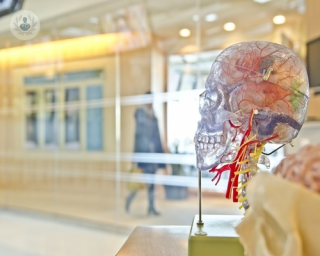Neurological disorders
Professor Peter Garrard - Neurology
Created on: 11-13-2012
Updated on: 03-23-2023
Edited by: Conor Dunworth
What are neurological disorders?
Neurological disorders are diseases of the central and peripheral nervous system – the brain, the spinal cord, the cranial and peripheral nerves, the autonomic nervous system, the nerve roots, the neuromuscular plate and the muscles.
There are more than six hundred neurological disorders. The most common are:
- diseases due to defective genes, such as muscular dystrophy or Huntington's disease
- degenerative diseases, such as Alzheimer's or Parkinson's
- diseases of the blood vessels that supply the brain, such as stroke
- problems in the development of the nervous system, such as spina bifida
- brain or spinal cord injury
- convulsive disorders, such as epilepsy
- brain tumours
- infections, such as meningitis

Prognosis of the disease
The prognosis of a neurological disorder can change significantly depending on the particular disease. In the case of degenerative diseases of the nervous system, such as Alzheimer's, they can become quite severe over time, and can eventually put the patient's life at risk. Some genetic diseases are also progressive, but if spotted early on can often be treated effectively.
In the case of convulsive disorders, such as epilepsy, the prognosis is usually better. A patient with epilepsy can generally manage their symptoms through treatment, although this may take several years.
Some forms of brain or spine injury are life-threatening, as are cardiovascular conditions such as stroke. A brain tumour can sometimes benign, but if it is cancer it requires timely treatment to improve the chance of survival.
What are the symptoms of neurological disorders?
Neurological disorders can cause a wide range of symptoms, including:
- headaches
- numbness or loss of strength in a limb
- dizziness
- fainting and loss of consciousness
- memory problems
- cognitive difficulties
- speech problems
- vision problems
- tremors, spasms, and involuntary contractions
Medical tests for neurological disorders
Medical tests may vary depending on the affectation that the patient has. There are multiple tests to evaluate the state of the nervous system, which are more useful depending on what one wants to check. The following should be highlighted:
- Electroencephalogram: is especially useful in brain tumors or brain or spinal cord inflammation, for example.
- Cerebral angiography: used to locate vascular irregularities in the brain. They can be obstructions in the blood vessels or stroke, among others.
- Computed tomography: very effective in the detection of epilepsy, brain tumors or cysts, brain damage by injury, etc.
- Magnetic resonance: this reveals to the doctor the details of organs, tissues, nerves and bones.
- Lumbar puncture: to obtain samples of cerebrospinal fluid and thus check the existence of bleeding or cerebral hemorrhages.
Can neurological disorders be prevented?
In many cases, neurological disorders are difficult to prevent, especially when they are due to hereditary factors. However, there are a number of lifestyle changes that can reduce the risk of stroke, and which are thought to reduce the risk of developing dementia later in life:
- do some physical exercise on a regular basis
- avoid social isolation by keeping up with family and friends and getting involved in your local community
- avoid the consumption of alcohol, tobacco and illegal drugs
- get a good night’s sleep (6-8 hours a day)
- maintain a balanced diet with plenty of fruit and vegetables
- avoid brain injuries by using the necessary protection on the road or when doing extreme sport
- avoid medical risk factors such as high blood pressure, high cholesterol, stress, exhaustion, obesity, or diabetes

Treatments for neurological disorders
There are multiple treatments for neurological disorders, which can vary depending on the condition. Normally, the main treatment consists of neurorehabilitation, which aims to restore, minimise or compensate functional deficits that the patient may have, but setting realistic expectations as to what is possible.
In some cases it is possible to mitigate some symptoms with medication or surgery. Overall, treatment aims to improve the quality of life of patients suffering from a neurological disorder, so that they can have the greatest possible independence. In all neurological disorders, an early diagnosis is vital, so that the specialist can establish the most appropriate treatment in each case.
What is the most severe neurological disorder?
Of course, this can vary from person to person, but stroke is generally considered the most severe neurological disorder, due to the common nature of the condition, and the severe disabilities it can cause.
A stroke occurs when the oxygen supply to the brain is cut off. This can be life-threatening, but can also lead to severe disabilities that can limit the patient’s cognitive functions. This can also have a a negative psychological impact.
Do neurological disorders become more common as we age?
Neurological disorders are more common in people over the age of sixty-five. Examples of these disorders include:

Which specialist treats neurological disorders?
Neurologists typically diagnose and treat neurological disorders.
















